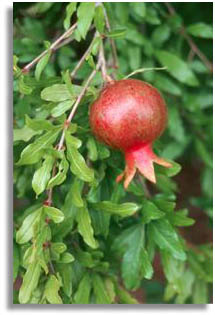September
2005
Small plant size, attractive flowers and unique fruits make the pomegranate
an excellent landscape plant, according to
LSU AgCenter
horticulturist Dr. John Pyzner. It has been grown as a fruiting shrub or
small tree in many of the old Louisiana gardens.
Pomegranates tolerate Louisiana’s humid climate, but they have thrived
in the semi-arid climate of the Mediterranean and Middle East regions since
ancient times. |

LSU AgCenter Photo |
The natural growth pattern of a pomegranate is a dense deciduous
shrub 8-15 feet tall. The plants are sometimes pruned to single-trunk
trees that grow 15-20 feet tall. The tree style requires frequent
pruning of suckers from around the main trunk to maintain the form.
Pomegranates can withstand temperatures near 0 F when they are
dormant. Before dormancy, however, they are very sensitive to early
fall freezes. They also are vulnerable to late spring freezes when
buds begin to swell. In areas where early or late freezes are a
problem, pomegranates are best grown as a shrub.
Pyzner says pomegranates are tolerant of most growing conditions
except wet soils. The best growing conditions for pomegranates are
sunny locations with a well-drained, moist heavy loam soil. Plants
can grow in partial shade, in sandy or clay soils, in drought
conditions and in a broad soil pH range.
Pomegranates have very showy flowers in the spring. These flowers may
be an inch or 2 in diameter. Most flowers are a dark orange to red.
Flowers also can be white, yellow or pink.
Pyzner explains that flowers may have a single set of petals, or they
may have multiple sets of petals that give flowers a carnation
appearance.
Pomegranates are self-pollinating. Two types of flowers are
frequently present. One type has a pistil and pollen and is capable
of producing fruit. These flowers normally have a U-shaped base. The
second type produces only pollen and will not set fruit. This type of
flower usually has a V-shaped base. Humid conditions during blooming
can prevent fruit set. Severe fruit drop is common on young plants
3-5 years old.
The fruit is 2-5 inches in diameter. It has a leathery rind that is
usually yellow and overlaid with pink or red. The interior of the
fruit is filled with seeds that are surrounded by white, pink or red
juicy pulp. The juicy pulp is the edible part of the fruit. The fruit
ripens in September and October.
Wonderful and Sweet are the two varieties of fruiting pomegranates
most likely to be available. Pomegranate fruits more probably are
used for decorations rather than consumption, since they are so
unique and attractive and keep well at room temperatures.
A number of ornamental pomegranates are available. Nana is the most
common variety. It is a dwarf that grows 2-4 feet tall and has
individual orange-red flowers.
Other varieties are available, but they are more difficult to locate.
They vary in flower color and plant size.
For related horticulture topics, click on the Lawn and Garden link at
the LSU AgCenter Web site,
www.lsuagcenter.com.
|